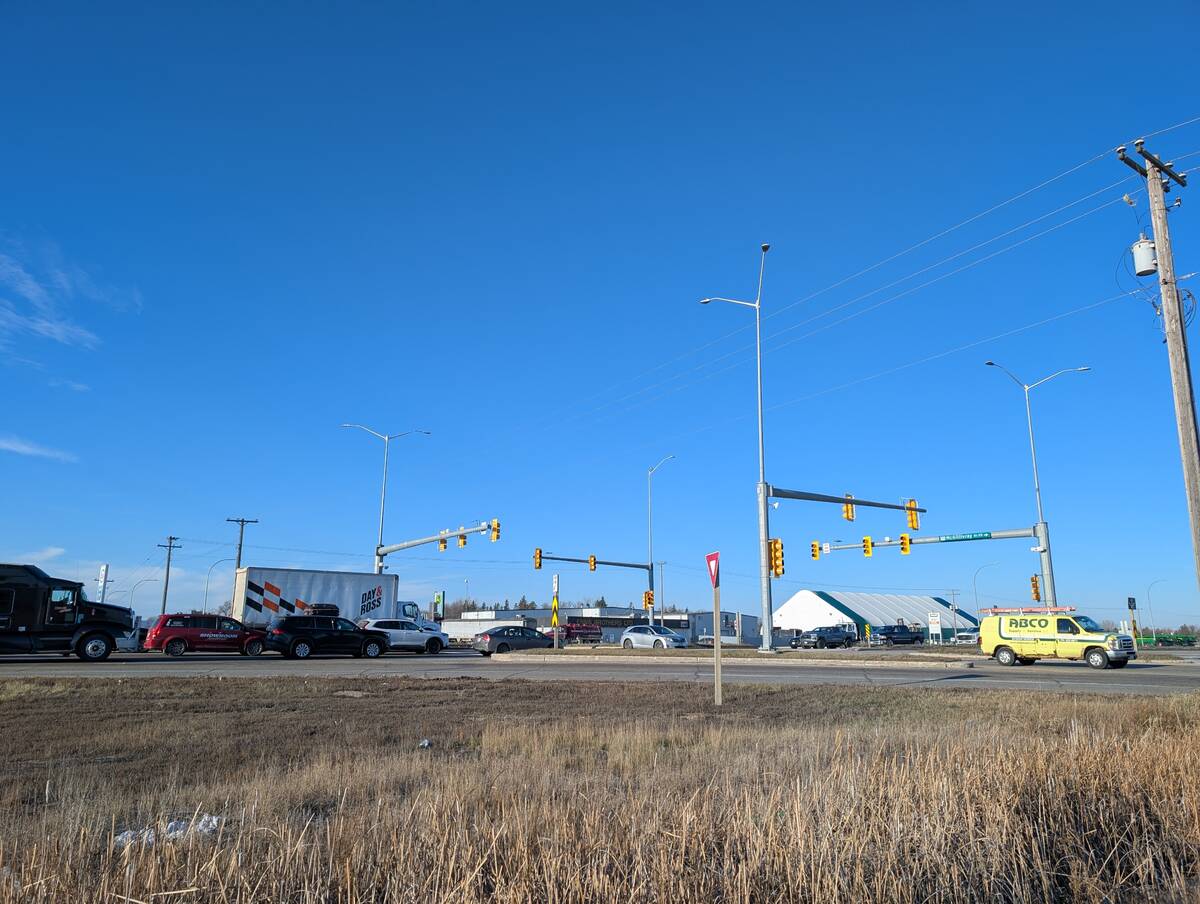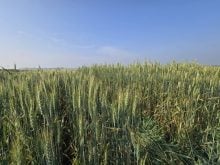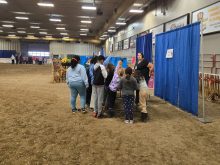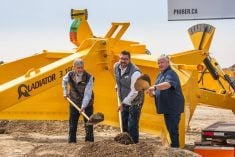A livestock researcher in Alberta wants to see if virtual fencing lives up to its promises once winter hits the Prairies.
“If you have a technology that can’t work in -40 or -45, it has no place in Alberta,” said Lakeland College’s Obioha Durunna during a Sept. 14 presentation to Manitoba producers north of Brandon.
Why it matters: Virtual fencing could fundamentally change the labour and infrastructure required to run cattle, assuming it works and producers can manage the price tag.
Read Also

Manitoba farmers uneasy on expropriation
Farmland expropriation for Oak Bluff highway project brings process, farmer compensation concerns back to the fore.
The virtual fencing tests are an offshoot of an ongoing swath grazing study that compares the production and profitability of the practice in cereal monoculture (oats) versus a multi-species forage mix.
The three-year project began in 2021. A 30-acre site was divided into six five-acre paddocks. Durunna seeded the areas with either CDC SO-1 oats or a forage blend that consisted of oats, turnips, rapeseed and forage peas.
The paddocks were set up with electric fencing. In the first year of the study, 42 cattle were divided evenly among the six paddocks. Cattle were initially allowed to graze the first 40 feet of the paddocks. The fence was then moved a further 40 feet through the course of the study, giving animals access to fresh swaths.
In the second year, Durunna changed tactics. The number of cattle was raised to 60 in the 2022-23 grazing season and half were fitted with virtual fencing collars.
Hi-tech swath grazing
Durunna had seen growing interest in virtual fencing among livestock farmers, and he also knew there was a knowledge gap regarding how the technology works. So, when Ed Bork of the University of Alberta’s Rangeland Research Institute offered to let him borrow 30 collars, he gladly accepted.
“These tools need to be tested before producers jump on them,” said Durunna. “I think that’s what research institutions are supposed to do — help these producers navigate the world of emerging technologies. For us it was also a learning opportunity.”

The virtual fencing system was from a Norwegian company called NoFence. It consists of a collar worn by the animal and an app that can be downloaded onto a tablet or smart phone. The app and the collar communicate over the mobile network, which allows the app to monitor animals and notify the operator if something unexpected happens.
The collar emits a tone if an animal approaches the boundary and gives a one- to three-kilovolt shock if it crosses. It is said to take about a week of training for the animals to understand the connection between the tone and the shock.
“Some of them learned within a day or two,” said Durunna. “All they need is to associate the tone with the electric pulse that they will receive. If they get close to the virtual boundary, that’s when the tone comes up, and the best way to stop that tone is to turn around. So once they learn that, that’s it.”
He didn’t want to jeopardize the data collected for the swath grazing study, so he left the conventional fencing in place as insurance in case the virtual fencing failed.
Thus there were no labour savings, which are main advantage promised by the technology:
But after his first year of testing, Durunna said he’s confident the collars are an effective tool to manage and track livestock.
“Some managed to sneak through, but this happened probably only two times,” he said.
In terms of how the system performed over a cold Prairie winter, Durunna said he was impressed.
“We were surprised in terms of average battery life. They really hold up. We saw that they had over 95 per cent charge retention.”
As Durunna enters the final year of his study, he hopes to acquire more collars for the cattle.
“We didn’t have enough collars [last year]. We had 60 steers and only 30 collars. If you have some with collars and some without, those without collars can sneak through the fence, but the ones with collars cannot.
“It kind of brings up some behavioural dynamics. So, this year, we’re planning to put collars on all the animals.”
Past efforts
Durunna’s research trials aren’t the first to test virtual fencing in Canada and probably won’t be the last.
In 2021, a pilot program in British Columbia tested it in the wake of wildfires that required extensive fence rebuilding at a high cost.
A project initiated by the Saskatchewan Stock Growers Association also aims to evaluate the technology in northern Saskatchewan.
That project was originally slated to begin this year, but Merck Animal Services recently acquired the company (Vence), which was to provide the virtual fencing system. The SSGA project was put on the back burner as a result.
Chad MacPherson, general manager of the SSGA, said a cattle producer in the region approached his organization about testing the technology.
“When you’re having to push through solid bush and bog in different areas, or if you have short-term leases on forestry or First Nations land and it’s unknown how long you’ll have access to it, it makes economic sense,” MacPherson said.
Aside from time and money saved in terms of building and maintaining physical fencing, it can also help ensure that cattle are getting into different areas.
“Cows just naturally want to find places close to water bodies to camp out on, but if you can force them to get out further and utilize more of the grass, it’s more efficient and economically viable. Especially if you’re going through a forest,” said MacPherson. “It makes most economic sense in situations where fencing is cost prohibitive.”
The Saskatchewan study is back on track and set to begin next year.
“We are hoping to get the base tower set up in the fall, do some training with the producer on the software and be prepared to roll it out in the spring for the grazing season,” MacPherson said.
Competition
In addition to Vence and NoFence, other companies are vying for a piece of the virtual fencing market. Gallagher Animal Management, out of New Zealand, produces the e-Shepherd system, while HerdWhistle, out of Calgary, is the lone Canadian company in the marketplace with its CattleShield product.
“One thing that they all have in common is limited availability,” said Durunna. “So I think they’re either being rolled out gradually or they don’t have the capacity to manufacture enough to meet the demands.”
None of the companies appear to be clamouring for new customers. Vence has a notice on its website indicating it is only working with large-scale operations. Gallagher asks customers to fill out a form to see if they qualify. NoFence has a note requesting producers to register, saying they will let customers know when products are available.
HerdWhistle could not be reached for comment.
Once economies of scale start to do their thing, Durunna sees a bright future for the technology.
“They are very convenient and very simple to use for producers, but cost is a huge barrier,” he said, noting the units cost more than $300 each.
“For it to be economical, it has to beat the cost of setting up physical fencing. Right now, I think it works better for folks with smaller herd sizes and bigger spaces, such that they could rotationally graze a few animals on a few acres.”
















